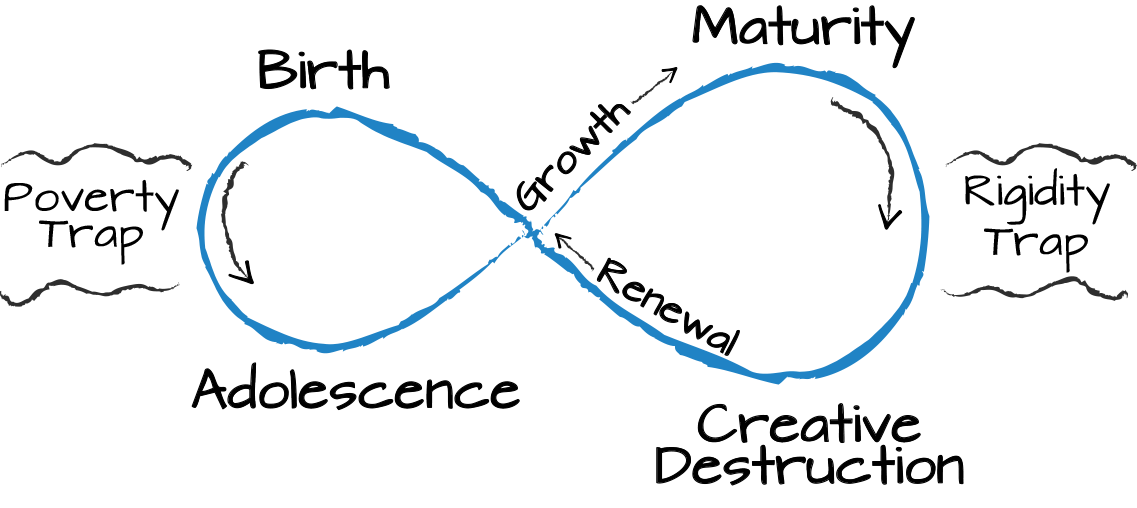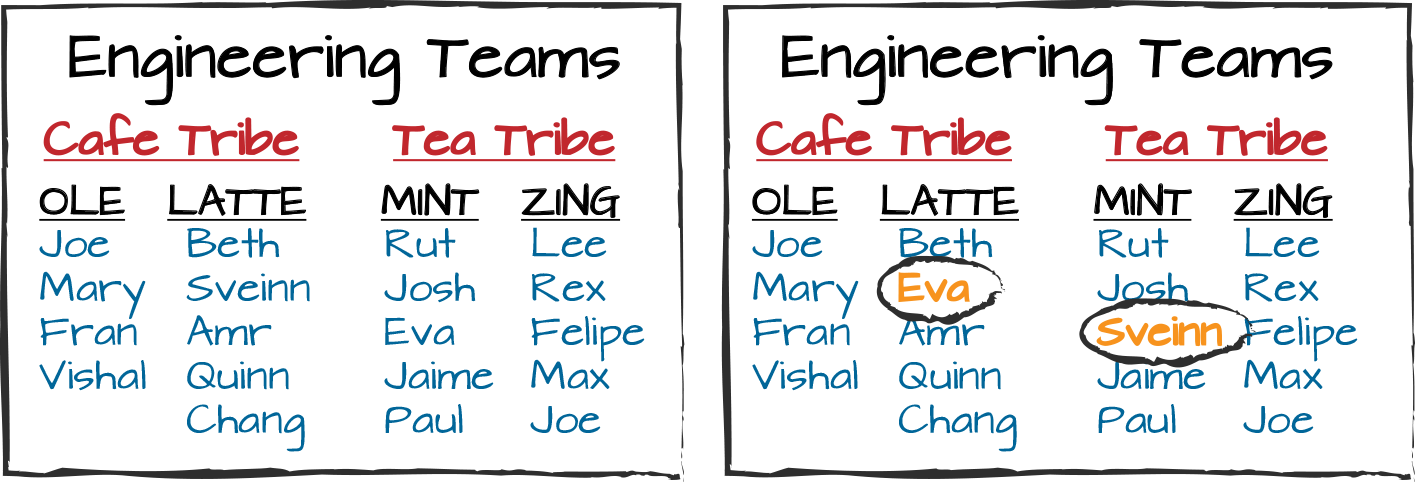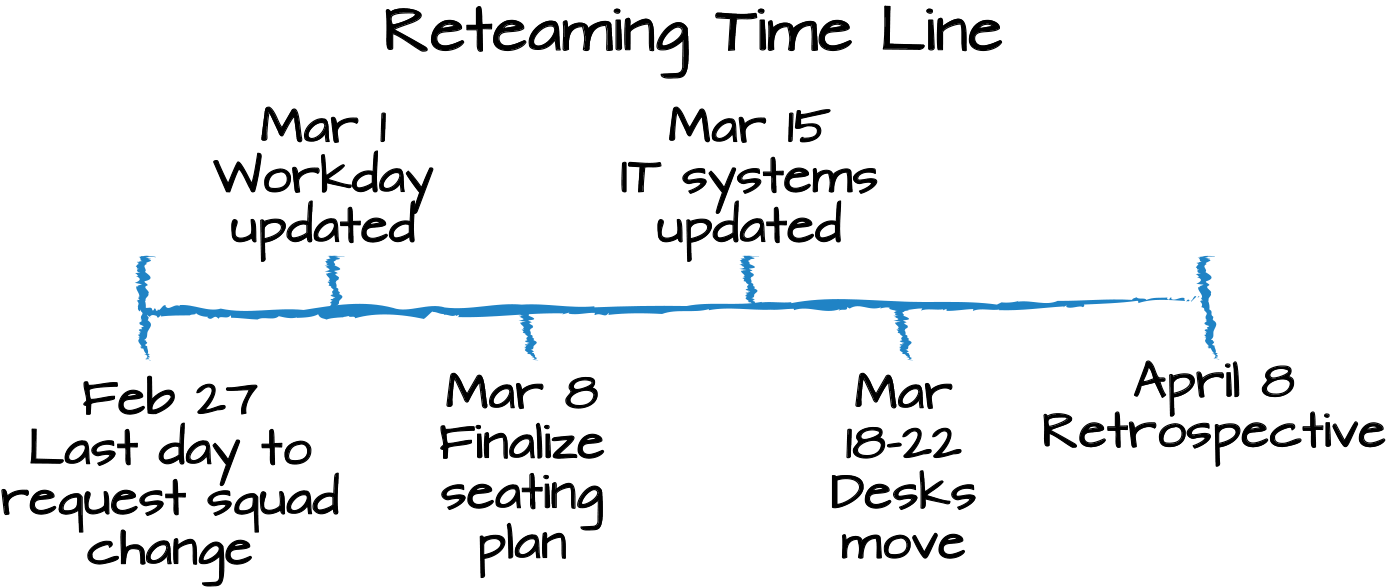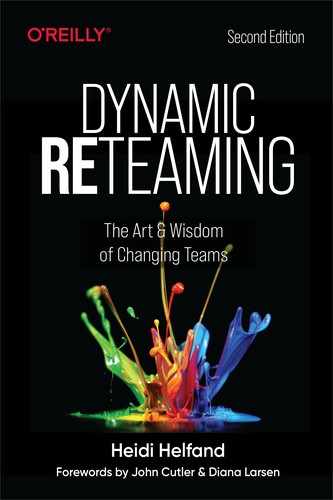Chapter 12. Plan Your Dynamic Reteaming Initiative
It’s no small feat to plan a large-scale reteaming event that spans multiple teams. You might be changing the organizational structure and moving the people around within that new structure. Or, it could be that you are keeping the structure the same, but you’re just moving around the people within it.
It could get even more complex. Maybe your company has acquired another company and you are blending together, as described in Chapter 8.
Or, maybe hierarchies are emerging in your context, and there are many shifts related to people management and structure. Peers might be promoted to manage their former peers, and the familiar, flat structure you knew before is now getting reshaped into a top-down triangle.
It could also be that your company priorities have changed, and because of that, some work must be paused or cancelled altogether, and the people need to be reassigned to different, higher-priority efforts elsewhere in the organization.
Whatever the case, doing larger reteamings takes careful planning and consideration for the people.
Even with the best intentions, we can be unskillful with this type of situation. Sometimes it feels like no matter what you try, someone is still upset and is feeling that things should have been done differently. This stuff isn’t easy, and it often garners a lot of fear. People fear the loss of role, status, or their jobs—even when they are as safe as they can be. Change triggers fear.
So what can we do? I think we need to recognize that it’s inevitable that you will restructure as your organization grows and evolves. It’s very much worth the time investment to plan and anticipate scenarios that might come up in order to increase your chances of success, which is the purpose of this chapter.
Remember the ecocycle metaphor from Chapter 1, as shown in Figure 12-1?

Figure 12-1. An ecocycle based on the adaptive cycle by Gunderson and Holling, Panarchy; and Keith McCandless et al., Liberating Structures
When you catalyze a reteaming, you are really igniting creative destruction. Some people will be ready for it and might even crave it, while others would prefer to not go through that disruptive change and instead want things to stay the same.
In this section, I pose a variety of questions for you to consider when planning large-scale changes so that you can formulate your own plan, and bring in any outside help you may need in order to finalize and execute on your plan.1
There is no “one size fits all” reteaming. Reteaming is complex and shows up in the patterns described in this book. You can’t just install dynamic reteaming into your organization. Frankly, it’s quite nuanced and challenging. When you ignite reteaming deliberately, you need to prepare. So let’s get started by analyzing what you’re trying to do when embarking on a reteaming initiative. I suggest that you keep track of your approach by creating a Frequently Asked Questions (FAQ) document that explains your initiative. The rest of this chapter is built using that lens.
Create Your Dynamic Reteaming FAQ
An FAQ document is a tool that helps you get really clear on what you’re trying to accomplish with your reteaming initiative by anticipating the questions that might come up.
The act of creating this FAQ, which is comprised of questions and answers stored in a shared document, will bring alignment within your leadership group that is in charge of the reteaming, and it will bring some clarity about the plan to the people who are impacted.
Here are some question areas for you to explore and consider integrating into your own FAQ.
What Are the Problems Solved by This Reteaming?
When your organization changes, the people want to know why. Is it due to growth? Are you preparing to go public? Are you trying to have a more scalable structure for the future? Or is it that you need to change your structure due to budget constraints? If you don’t anchor to why, your reteaming initiative will not make sense, and it will appear as if you are doing it for the sake of doing it without any good reason. Articulate the why to show respect for the people in your organization who will be impacted by the reteaming.
How Will People Get Assigned to Teams?
As we saw in Chapter 3, there are different approaches to assigning people to teams. Determine how much inclusion in team assignment you are willing to give the people impacted by the reteaming. Are the managers going to determine the final structure and cascade the decision to the teams? Are the managers going to first seek input from the people and then determine the final team structures? Or is the organization wanting to embark on a more inclusive reteaming event, such as visualizing potential changes on whiteboards, or by having an open reteaming event? Align on this approach within your reteaming leadership team, and then articulate your plan in your FAQ. For step-by-step instructions on how to do a whiteboard reteaming, see Appendix A. To learn how to run a marketplace for team selection, see Appendix B.
How Will People Find Out Whether They Have a New Team Assignment?
When you begin a reteaming initiative, you need to have clarity on what the impacts are to every person involved. In some cases, you need to consider questions like the following:
-
Does anyone get a new title?
-
Is anyone changing roles?
-
Is anyone becoming a manager who wasn’t one before?
-
Is anyone getting a new manager?
-
Is anyone now shared between teams who wasn’t before?
-
Is anyone getting a promotion and raise?
-
Is there a need to hire new people into the company because of the changes?
You also need to be sure that you don’t forget anyone in the change. It probably seems odd to read that, but I’ve seen it happen.
There are upsides and downsides for people during some reteaming events. Knowing and predicting how each person will be impacted is imperative so that you can talk with them about it and understand their needs. If people keep the same manager, it’s generally less disruptive.
How Are Existing Teams Impacted in Particular?
Another dimension to consider is whether any existing teams are going to stay the same, or if they are going to change with your reteaming initiative. In particular, the following questions come to mind:
-
Are any of the teams splitting or dissolving?
-
Are any teams acquiring remote employees that they didn’t have before?
If a team was colocated and now it has remote team members joining, there are collaboration obstacles that they will need to overcome. The day-to-day norms of the teams will change if their team membership changes extensively. They could use a calibration session if this occurs. See Chapter 13.
How Is Existing Work Impacted?
More than once in my career I have seen work “paused,” either temporarily or indefinitely. Even with the best of plans to come back to work later, that sometimes never happens. It is extremely demotivating to have worked months, and sometimes years, on a product or service and then it’s terminated. It’s happened to me. It’s happened to colleagues. If that is a repeated problem at your company, there are larger problems. Validating customer need is where I would look in order to stop the pause work and reallocate the people anti-pattern. On the other hand, drastic changes in work focus could be a pivot to save the company, like in the case of the Expertcity marketplace dissolution mentioned the preface. So at times it’s completely necessary. Nonetheless, you need to address any work impacts within your FAQ.
What Is the Composition of the New Teams?
Sometimes new teams are seeded with one to two people while the company is hiring for the rest of the people. Know what you’re getting into with this by rereading “Seeding Teams”, and, by all means, include the team members in the hiring of the rest of their team. Partially staffed teams can be a challenging situation that is stressful to people if they don’t have all of the skills required to do the work of the team. I would avoid it if possible.
Also, avoid excessive sharing of people between teams. The more cross-team sharing of people, the more meeting overhead these people will have, as well as context switching. If you do have a lot of people shared between two teams, for instance, you might consider what it would be like if they were one big team instead. And if you do that, be mindful of facilitation during meetings—you will need it.
What Does the Organization Look Like Before and After the Reteaming?
Create a before-and-after visual representation of your reteaming. Make a copy of your before picture. Denote any changes in another color so that they stand out. You can do this on whiteboards if the scope of change will fit. You can do it in an online document that you share. Figure 12-2 shows a very simplistic example of visualizing team changes.

Figure 12-2. Example of visualizing the before and after
Even if you’re not reteaming right now, having a visual of who is on what team can help people when they forget each others’ names—which happens a lot when your company is growing fast.
What Technology Systems or Other Equipment Needs to be Updated or Acquired with the Reteaming Initiative?
Once your teams change, you want them to be able to start working together immediately. With some advanced planning, you can make this go smoother. Getting any tooling ready in advance is what comes to mind. What do your teams rely on to get their work done? Think about the tools that your teams use, as well as any adjustments you will need to make to the tools to ensure the workflow gets off to a good start. For example, consider updating the tools your company might use for tracking management-to-direct-report relationships, for managing your code repository, for managing your work tickets or user stories, for managing documentation, and for managing online communication such as chat or email.
What Seating or Office Changes Will Take Place Along with the Reteaming?
If you work in a physical office, there are likely IT and facilities implications of your reteaming, so plan for them in advance. It would be great if all of our work facilities were set up so that we could move our desks around whenever we want. For some that is not so easy because furniture is relatively fixed in place. Working with your IT and facilities departments in advance can help get any desk moves coordinated in step with your reteaming time line. If your entire team is remote, this whole situation is quite simplified, except for time-zone implications if people are located around the globe.
What Training or Education is Needed with the Reteaming?
Many times your newly formed or changed teams are a forcing function for learning. In particular, consider what new areas people need to grasp in order to be successful. For instance, do your engineers need to learn how to code in a different programming language? Is there a new domain area that they need to understand and master, like accounting? What is the age, quantity, and quality of any existing code that they will be working with in the new team? Have they seen anything like it before? Does it have tests? Taking these thoughts into consideration is kind to team members and attempts to acknowledge the reality that they need some ramp-up time in order to be fully productive.
What Is the Communication Plan for the Reteaming Initiative?
Besides coming up with your new reteaming structure, you need to communicate really well about it. In particular, take into consideration questions like the following:
-
Who needs to know what, and when?
-
How will you inform the team members impacted by the changes?
-
How will you inform the people who interact with those impacted?
Planning the communication is not to be taken lightly. Some organizations even have communication specialists who are skilled in crafting “the messaging.”
Reteaming is change, and it can cause fear in your organization. In one reteaming I’ve been involved with, a team member heard about it and asked if there were going to be any layoffs. That was so incredibly far from the truth because our reteaming involved hiring more than 20 people. People make assumptions when they hear partial information, and fear kicks in. This is what you are trying to prevent, and frankly it’s tricky.
In his book, The Advantage, Patrick Lencioni advises communicating about any key issue or change at least seven times. This can’t be underemphasized.
Include in your FAQ the list of forums where people can find out more about the reteaming. Consider having daily standups about the reteaming offered in the same location and inclusive of any remote team members. You could also have a weekly all-hands meeting with your department to go over key information about the reteaming with an “ask me anything” component to it.
What Is the Schedule for the Reteaming Initiative?
Ideally you will have a lead for the reteaming initiative who will be the overall project manager for this change. That lead can create a time line with milestones and drive it so your reteaming moves along and does not stagnate. This lead can send regular updates on the status of the reteaming to the pertinent online channels. Here are some key milestones from a reteaming initiative I was part of, shown in Figure 12-3.

Figure 12-3. An example reteaming time line
Structure and communication about your reteaming initiative is important so you can try to decrease the uncertainty and confusion that will always be present.
What is the Feedback Plan for the Reteaming Initiative?
Plan a retrospective or survey that will be conducted when you declare the reteaming to be done. Ask: How did it go? What did you learn? The step that is sometimes forgotten is closing the loop and learning how we can do reteamings better next time in our organization. Taking the time to send a follow-up survey, or holding an in-person retrospective meeting after the fact is suggested. Refer to the survey template in Appendix C as a baseline to modify and send out in your organization.
Although this list of questions to consider for your reteaming is extensive, it’s likely not exhaustive. You most likely have context-dependent requirements for organizational change like this. Take the time to think it through with your collaborators and communicate often.
If you haven’t embarked on a larger-scale reteaming before, maybe this section has shed some light on the complexities of the endeavor. Invest the time to plan for a larger reteaming. You’ll be glad you did. I always try to operate such that I can give it my all, with the goal that I will look back on the reteaming and feel proud of how it was planned and executed. Be kind to yourself and know that things will go wrong. This stuff is not easy to do.
Once you have reteamed, you might think your teams are ready to hit the ground running. While that may be true for some teams and individuals, it could be that, for others, there is still a great deal of transition happening. That, as well as how to deliberately start up your teams, is the subject of the next chapter.
1 See chapter 10 in the “Guide to Managing Human Resources” from the University of California, Berkeley, which digs even further into this subbject. There is also an interesting 2010 McKinsey report on reorgs titled, “Taking Organizational Redesigns from Plan to Practice: McKinsey Global Survey Results”. These materials, as well as years of experience, have definitely inspired my thoughts on planning larger reteamings.
